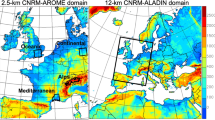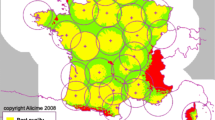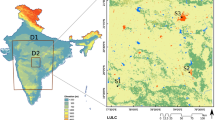Abstract
The convection-permitting regional climate model CNRM-AROME was applied on a spatial domain restricted to the northern half of France for analyzing its performances in simulating the urban climate of Paris region, and its potential added value compared to the regional climate model CNRM-ALADIN. In addition to its fine horizontal resolution (2.5 km compared to 12.5 km for CNRM-ALADIN), CNRM-AROME has the advantage of integrating the urban canopy model TEB into its land-surface modeling system. A hindcast simulation was performed for the past period 2000–2017, following an evaluation configuration for which CNRM-AROME was driven by CNRM-ALADIN, driven itself by the ERA-Interim reanalyses. Long-term gridded observations with kilometric resolution allowed a fine spatial scale evaluation of the atmospheric variables simulated by both models. They showed in particular a significant overestimation of spring precipitation, but an improvement of summer precipitation in CNRM-AROME compared to CNRM-ALADIN. Above all, thanks to its horizontal resolution and the use of a dedicated urban model, CNRM-AROME was shown to offer significant added value for the simulation of urban heat islands, for the mapping of heat-warming areas, and for representing the effects of the city on precipitation. It is a promising tool to diagnose climatic and impact indicators at the city scale, and their evolution in a changing climate.











Similar content being viewed by others
Data availability
The datasets generated during and/or analysed during the current study are available from the corresponding author on reasonable request.
References
Bokwa A, Hajto MJ, Walawender JP, Szymanowski M (2015) Influence of diversified relief on the urban heat island in the city of Kraków, Poland. Theor Appl Climatol 122:365–382. https://doi.org/10.1007/s00704-015-1577-9
Boone A, Calvet J-C, Noilhan J (1999) The inclusion of a third soil layer in a Land surface scheme using the force-restore method. J Appl Meteor 38:1611–1630. https://doi.org/10.1175/1520-0450(1999)038%3c1611:IOATSL%3e2.0.CO;2
Boone A, Masson V, Meyers T, Noilhan J (2000) The influence of the inclusion of soil freezing on simulations by a soil–vegetation–atmosphere transfer scheme. J Appl Meteor 39:1544–1569. https://doi.org/10.1175/1520-0450(2000)039%3c1544:TIOTIO%3e2.0.CO;2
Brousseau P, Seity Y, Ricard D, Léger J (2016) Improvement of the forecast of convective activity from the AROME-France system. Q J R Meteorol Soc 142:2231–2243. https://doi.org/10.1002/qj.2822
Caillaud C, Somot S, Alias A, Bernard-Bouissières I, Fumière Q, Laurantin O, Seity Y, Ducrocq V (2021) Modelling Mediterranean heavy precipitation events at climate scale: an object-oriented evaluation of the CNRM-AROME convection-permitting regional climate model. Clim Dyn 56:1717–1752. https://doi.org/10.1007/s00382-020-05558-y
Carabajal CC, Harding DJ, Boy J-P, Danielson JJ, Gesch DB, Suchdeo VP (2011) Evaluation of the Global Multi-Resolution Terrain Elevation Data 2010 (GMTED2010) using ICESat geodetic control, Proc. SPIE 8286, International Symposium on Lidar and Radar Mapping 2011: Technologies and Applications, 82861Y.
Champeaux J-L, Masson V, Chauvin F (2005) ECOCLIMAP: a global database of land surface parameters at 1 km resolution. Met Apps 12:29–32. https://doi.org/10.1017/S1350482705001519
Coppola E, Sobolowski S, Pichelli E, Raffaele F, Ahrens B, Anders I, Ban N, Bastin S, Belda M, Belusic DA, Caldas-Alvarez A, Cardoso RM, Davolio S, Dobler A, Fernandez J, Fita L, Fumiere Q, Giorgi F, Goergen K, Güttler I, Halenka T, Heinzeller D, Hodnebrog Ø, Jacob D, Kartsios S, Katragkou E, Kendon E, Khodayar S, Kunstmann H, Knist S, Lavín-Gullón A, Lind P, Lorenz T, Maraun D, Marelle L, van Meijgaard E, Milovac J, Myhre G, Panitz H-J, Piazza M, Raffa M, Raub T, Rockel B, Schär C, Sieck K, M. Soares PM, Somot S, Srnec L, Stocchi P, Tölle MH, Truhetz H, Vautard R, de Vries H, Warrach-Sagi K, (2020) A first-of-its-kind multi-model convection permitting ensemble for investigating convective phenomena over Europe and the Mediterranean. Clim Dyn 55(1):3–34. https://doi.org/10.1007/s00382-018-4521-8
Daniel M, Lemonsu A, Déqué M, Somot S, Alias A, Masson V (2019) Benefits of explicit urban parameterization in regional climate modeling to study climate and city interactions. Clim Dyn 52(5–6):2745–2764. https://doi.org/10.1007/s00382-018-4289-x
Decharme B, Boone A, Delire C, Noilhan J (2011) Local evaluation of the Interaction between Soil Biosphere Atmosphere soil multilayer diffusion scheme using four pedotransfer functions. J Geophys Res 116:D20126. https://doi.org/10.1029/2011JD016002
Dee DP, Uppala S, Simmons A, Berrisford P, Poli P, Kobayashi S, Andrae U, Balmaseda M, Balsamo G, Bauer DP, Bechtold P, Beljaars ACM, van de Berg L, Bidlot J, BormannN DC, Dragani R, Fuentes M, Geer AJ, Haimberger L, Healy SB, Hersbach H, Hólm EV, Isaksen L, Kållberg P, Köhler M, Matricardi M, McNally AP, Monge-Sanz BM, Morcrette J-J, Park B-K, Peubey C, de Rosnay P, Tavolato C, Thépaut J-N, Vitart F (2011) The ERA-Interim reanalysis: configuration and performance of the data assimilation system. Q J R Meteorol Soc 137(656):553–597. https://doi.org/10.1002/qj.828
Déqué M, Alias A, Somot S, Nuissier O (2016) Climate change and extreme precipitation: the response by a convection-resolving model. In: Research activities in atmospheric and oceanic modelling CAS/JSC Working group on numerical experimentation Report No. 46
Faroux F, Kaptué Tchuenté AT, Roujean J-L, Martin E, Masson V, Le Moigne P (2013) ECOCLIMAP-II/Europe : a twofold database of ecosystems and surface parameters at 1-km resolution based on satellite information for use in land surface, meteorological and climate models. Geosci Model Dev 6:563–582. https://doi.org/10.5194/gmd-6-563-2013
Founda D, Santamouris M (2017) Synergies between Urban Heat Island and Heat Waves in Athens (Greece), during an extremely hot summer (2012). Sci Rep 7:10973. https://doi.org/10.1038/s41598-017-11407-6
Fumière Q, Déqué M, Nuissier O, Somot S, Alias A, Caillaud C, Laurantin O, Seity Y (2020) Extreme rainfall in Mediterranean France during the fall: added value of the CNRM-AROME convection-permitting regional climate model. Clim Dyn 55:77–91. https://doi.org/10.1007/s00382-019-04898-8
Haeffelin M, Barthès L, Bock O, Boitel C, Bony S, Bouniol D, Chepfer H, Chiriaco M, Cuesta J, Delanoë J, Drobinski P, Dufresne J-L, Flamant C, Grall M, Hodzic A, Hourdin F, Lapouge F, Lemaître Y, Mathieu A, Morille Y, Naud C, Noël V, O’Hirok W, Pelon J, Pietras C, Protat A, Romand B, Scialom G, Vautard R (2005) SIRTA, a ground-based atmospheric observatory for cloud and aerosol research. Ann Geophys 23:253–275. https://doi.org/10.5194/angeo-23-253-2005
Hamdi R, Masson V (2008) Inclusion of a drag approach in the town energy balance (TEB) scheme : offline 1-d validation in a street canyon. J Appl Meteor Climatol 47:2627–2644. https://doi.org/10.1175/2008JAMC1865.1
He B-J (2018) Potentials of meteorological characteristics and synoptic conditions to mitigate urban heat island effects. Urban Climate 24:26–33. https://doi.org/10.1016/j.uclim.2018.01.004
Hewitt CD, Lowe JA (2018) Toward a european climate prediction system. Bull Am Meteorol Soc 99(10):1997–2001. https://doi.org/10.1175/BAMS-D-18-0022.1
IPCC (2022) Climate Change 2022: Impacts, Adaptation, and Vulnerability. Contribution of Working Group II to the Sixth Assessment Report of the Intergovernmental Panel on Climate Change [Pörtner H-O, Roberts DC, Tignor M, Poloczanska ES, Mintenbeck K, Alegría A, Craig M, Langsdorf S, Löschke S, Möller V, Okem A, Rama B (eds.)]. Cambridge University Press. In Press
Jacob D, Petersen J, Eggert B, BøssingChristensen O, Bouwer LM, Braun A, Colette A, Déqué M, Georgievski G, Georgopoulou E, Gobiet A, Menut L, Nikulin G, Haensler A, Hempelmann N, Jones C, Keuler K, Kovats S, Kröner N, Kotlarski S, Kriegsmann A, Martin E, van Meijgaard E, Moseley C, Pfeifer S, Preuschmann S, Radermacher C, Radtke K, Rechid D, Rounsevell M, Samuelsson P, Somot S, Soussana JF, Teichmann C, Valentini R, Vautard R, Weber B, Yiou P (2014) EURO-CORDEX: new high-resolution climate change projections for European impact research. Reg Environ Change 14:563–578
Kassomenos P, Kissas G, Petrou I, Begou P, Khan HS, Santamouris M (2022) The influence of daily weather types on the development and intensity of the urban heat island in two Mediterranean coastal metropolises. Sci Total Env 819:153071. https://doi.org/10.1016/j.scitotenv.2022.153071
Kounkoud-Arnaud R, Brion D (2018) Optimal interpolation of daily temperatures around Paris, taking into account urban fraction. 10th International Conference on Urban Climate. New York, NY: Am Meteor Soc. https://ams.confex.com/ams/ICUC10/meetingapp.cgi/Paper/341760
Laaidi K, Zeghnoun A, Dousset B, Bretin P, Vandentorren S, Giraudet E, Beaudeau P (2012) The impact of heat islands on mortality in Paris during the August 2003 heat wave. Environ Health Perspect 120(2):254–259. https://doi.org/10.1289/ehp.1103532
Le Roy B, Lemonsu A, Kounkou-Arnaud R, Brion D, Masson V (2020) Long time series spatialized data for urban climatological studies: a case study of Paris. France Int J Climatol 40(7):3567–3584. https://doi.org/10.1002/joc.6414
Lemonsu A, Masson V, Shashua-Bar L, Erell E, Pearlmutter D (2012) Inclusion of vegetation in the town energy balance model for modelling urban green areas. Geosci Model Dev 5:1377–1393. https://doi.org/10.5194/gmd-5-1377-2012
Liu J, Niyogi D (2019) Meta-analysis of urbanization impact on rainfall modification. Sci Rep 9:7301. https://doi.org/10.1038/s41598-019-42494-2
Lorenz JM, Kronenberg R, Bernhofer C, Niyogi D (2019) Urban rainfall modification: observational climatology over Berlin, Germany. J Geophy Res: Atmos 124:731–746. https://doi.org/10.1029/2018JD028858
Lucas-Picher P, Argüeso D, Brisson E, Tramblay Y, Berg P, Lemonsu A, Kotlarski S, Caillaud C (2021) Convection-permitting modeling with regional climate models: latest developments and next steps Wiley Interdisciplinary Reviews. Clim Change 12(6):e731. https://doi.org/10.1002/wcc.731
Lucas-Picher P, Brisson E, Caillaud C, Alias A, Nabat P, Lemonsu A, Poncet N, Cortes Hernandez VE, Michau Y, Doury A, Monteiro D, Somot S (2022) Evaluation of the convection-permitting regional climate model CNRM-AROME41t1 over northwestern Europe. Clim Dyn, Submitted
Masson V (2000) A Physically-based scheme for the Urban energy budget in atmospheric models. Bound-Layer Meteorol 94:357–397. https://doi.org/10.1023/A:1002463829265
Masson V, Seity Y (2009) Including atmospheric layers in vegetation and urban offline surface schemes. J Appl Meteorol Climatol 48(7):1377–1397. https://doi.org/10.1175/2009JAMC1866.1
Masson V, Champeaux J-L, Chauvin F, Meriguet C, Lacaze R (2003) A global data base of land surface parameters at 1 km resolution in meteorological and climate models. J of Climate 16:1261–1282. https://doi.org/10.1175/1520-0442(2003)16%3c1261:AGDOLS%3e2.0.CO;2
Masson V, Le Moigne P, Martin E, Faroux S, Alias A, Alkama R, Belamari S, Barbu A, Boone A, Bouyssel F, Brousseau P, Brun E, Calvet J-C, Carrer D, Decharme B, Delire C, Donier S, Essaouini K, Gibelin A-L, Giordani H, Habets F, Jidane M, Kerdraon G, Kourzeneva E, Lafaysse M, Lafont S, Lebeaupin Brossier C, Lemonsu A, Mahfouf J-F, Marguinaud P, Mokhtari M, Morin S, Pigeon G, Salgado R, Seity Y, Taillefer F, Tanguy G, Tulet P, Vincendon B, Vionnet V, Voldoire A (2013) The SURFEXv7.2 land and ocean surface platform for coupled or offline simulation of Earth surface variables and fluxes. Geosci Model Dev 6:929–960. https://doi.org/10.5194/gmd-6-929-2013
Masson V, Lemonsu A, Hidalgo J, Voogt J (2020) Urban climates and climate change. Annu Rev Environ Resour 45:411–444. https://doi.org/10.1146/annurev-environ-012320-083623
Melecio-Vázquez D, Ramamurthy P, Arend M, González-Cruz JE (2018) Thermal structure of a Coastal-Urban boundary Layer. Bound-Layer Meteorol 169:151–161. https://doi.org/10.1007/s10546-018-0361-7
Michau Y, Lemonsu A, Lucas-Picher P, Caillaud C, Alias A (2023) Urban climate assessment using the CNRM-AROME CPM: the case of 12 French cities. Urban Climate 47:101386. https://doi.org/10.1016/j.uclim.2022.101386
Nabat P, Somot S, Cassou C, Mallet M, Michou M, Bouniol D, Decharme B, Drugé T, Roehrig R, Saint-Martin D (2020) Modulation of radiative aerosols effects by atmospheric circulation over the Euro-Mediterranean region. Atmos Chem Phys 20(14):8315–8349. https://doi.org/10.5194/acp-20-8315-2020
Nachtergaele F, Velthuizen H, Verelst L, Wiberg D (2012) Harmonized World Soil Database Version 1.2, FAO/IIASA/ISRIC/ISS-CAS/JRC.
Ngarambe J, Oh JW, Su MA, Santamouris M, Yun GY (2021) Influences of wind speed, sky conditions, land use and land cover characteristics on the magnitude of the urban heat island in Seoul: An exploratory analysis. Sustainable Cities Soc 71:102953. https://doi.org/10.1016/j.scs.2021.102953
Noilhan J, Planton S (1989) A simple parameterization of land surface processes for meteorological models. Mon Weather Rev 117(3):536–549. https://doi.org/10.1175/1520-0493(1989)117%3c0536:ASPOLS%3e2.0.CO;2
Oke T, Mills G, Christen A, Voogt J (2017) Urban Climates. Cambridge University Press, Cambridge. https://doi.org/10.1017/9781139016476
Pascal M, Lagarrigue R, Tabai A, Bonmarin I, Camail S, Laaidi K, Le Tertre A, Denys S (2021) Evolving heat waves characteristics challenge heat warning systems and prevention plans. Int J Biometeorol 65:1683–1694. https://doi.org/10.1007/s00484-021-02123-y
Pergaud J, Masson V, Malardel S, Couvreux F (2009) A Parameterization of dry thermals and shallow cumuli for mesoscale numerical weather prediction. Bound-Layer Meteorol 132:83–106. https://doi.org/10.1007/s10546-009-9388-0
Philip A, Bergot T, Bouteloup Y, Bouyssel F (2016) The impact of vertical resolution on fog forecasting in the kilometric-scale model arome: a case study and statistics. Weather Forecast 31:1655–1671. https://doi.org/10.1175/WAF-D-16-0074.1
Pigeon G, Zibouche K, Bueno B, Le Bras J, Masson V (2014) Improving the capabilities of the town energy balance model with up-to-date building energy simulation algorithms: an application to a set of representative buildings in Paris. Energy Build 76:1–14. https://doi.org/10.1016/j.enbuild.2013.10.038
Prein AF, Langhans W, Fosser G, Ferrone A, Ban N, Goergen K, Keller M, Tölle M, Gutjahr O, Feser F, Brisson E, Kollet S, Schmidli J, van Lipzig NPM, Leung R (2015) A review on regional convection-permitting climate modeling: demonstrations, prospects, and challenges. Rev Geophys 53(2):323–361. https://doi.org/10.1002/2014RG000475
Santamouris M, Haddad S, Fiorito F, Osmond P, Ding L, Prasad D, Zhai X, Wang R (2017) Urban heat island and overheating characteristics in Sydney, Australia An Analysis of Multiyear Measurements. Sustainability 9:712. https://doi.org/10.3390/su9050712
Schinasi LH, Benmarhnia T, De Roos AJ (2018) Modification of the association between high ambient temperature and health by urban microclimate indicators: a systematic review and meta-analysis. Environ Res 161:168–180. https://doi.org/10.1016/j.envres.2017.11.004
Seity Y, Brousseau P, Malardel S, Hello G, Bénard P, Bouttier F, Lac C, Masson V (2011) The AROME-France convective-scale operational model. Mon Weather Rev 139(3):976–991. https://doi.org/10.1175/2010MWR3425.1
Tabary P, Dupuy P, Lhenaff G, Gueguen C, Moulin L, Laurantin O, Merlier C, Soubeyroux JM (2012) A 10-year (1997–2006) reanalysis of Quantitative Precipitation Estimation over France: methodology and first results. IAHS-AISH publication, Wallingford, pp 255–260
Tan J, Zheng Y, Tang X, Guo C, Li L, Song G, Zhen X, Yuan D, Kalkstein AJ, Li F, Chen H (2010) The urban heat island and its impact on heat waves and human health in Shanghai. Int J Biometeorol. https://doi.org/10.1007/s00484-009-0256-x
Termonia P, Fischer C, Bazile E, Bouyssel F, Brožková R, Bénard P, Bochenek B, Degrauwe D, Derková M, El Khatib R et al (2018) The ALADIN system and its canonical model configurations AROME CY41T1 and ALARO CY40T1. Geosci Model Dev 11(1):257. https://doi.org/10.5194/gmd-11-257-2018
Theeuwes NE, Barlow JF, Teuling AJ, Grimmond CSB, Kotthaus S (2019) Persistent cloud cover over mega-cities linked to surface heat release. Npj Climate Atmos Sci 2:15. https://doi.org/10.1038/s41612-019-0072-x
Tong S, Wong NH, Tan CL, Jusuf SK, Ignatius M, Tan E (2017) Impact of urban morphology on microclimate and thermal comfort in northern China. Sol Energy 155:212–223. https://doi.org/10.1016/j.solener.2017.06.027
Tsiringakis A, Theeuwes NE, Barlow JF, Steeneveld G-J (2022) Interactions between the nocturnal low-level jets and the urban boundary layer: a case study over London. Bound-Layer Meteorol 183:249–272. https://doi.org/10.1007/s10546-021-00681-7
Wang M, Tang G, Liu Y, Ma M, Yu M, Hu B, Zhang Y, Wang Y, Wang Y (2021) The difference in the boundary layer height between urban and suburban areas in Beijing and its implications for air pollution. Atmos Environ 260:118552. https://doi.org/10.1016/j.atmosenv.2021.118552
Yang J, Hu L, Wang C (2019) Population dynamics modify urban residents’ exposure to extreme temperatures across the United States. Sci Adv 5(12):eaay3452. https://doi.org/10.1126/sciadv.aay3452
Zhang Y, Zhang J, Zhang X, Zhou D, Gu Z (2021) Analyzing the characteristics of UHI (Urban Heat Island) in summer daytime based on observations on 50 Sites in 11 LCZ (Local Climate Zone) types in Xi’an. China Sustainability 13:83. https://doi.org/10.3390/su13010083
Acknowledgements
The AROME model is developed from a collaboration between CNRM and CNRS laboratories involved in Meso-NH research, along with the international ACCORD consortium. For the present study, the authors acknowledge Denis Brion (Météo-France) for providing the gridded daily temperature data for the Ile-de-France region, SIRTA and FLUXNET Network for providing the radiation station data, Isabelle Pfaffenzeller (Météo-France) for providing the COMEPHORE dataset (available through AERIS platform : https://radarsmf.aeris-data.fr/), and Robin Lagarrigue (Santé Publique France) for providing heat-wave warning threshold data. The authors would also thank Samuel Somot for his comments and advice for some climatic analyses. consortium.
Funding
This work was partly supported by the French National Agency under the future investment program ANR-18-MPGA-0005.
Author information
Authors and Affiliations
Corresponding author
Ethics declarations
Conflict of interest
The authors have not disclosed any competing interests.
Additional information
Publisher's Note
Springer Nature remains neutral with regard to jurisdictional claims in published maps and institutional affiliations.
Rights and permissions
Springer Nature or its licensor (e.g. a society or other partner) holds exclusive rights to this article under a publishing agreement with the author(s) or other rightsholder(s); author self-archiving of the accepted manuscript version of this article is solely governed by the terms of such publishing agreement and applicable law.
About this article
Cite this article
Lemonsu, A., Caillaud, C., Alias, A. et al. What added value of CNRM-AROME convection-permitting regional climate model compared to CNRM-ALADIN regional climate model for urban climate studies ? Evaluation over Paris area (France). Clim Dyn 61, 1643–1661 (2023). https://doi.org/10.1007/s00382-022-06647-w
Received:
Accepted:
Published:
Issue Date:
DOI: https://doi.org/10.1007/s00382-022-06647-w




